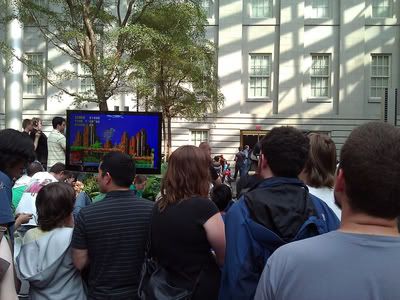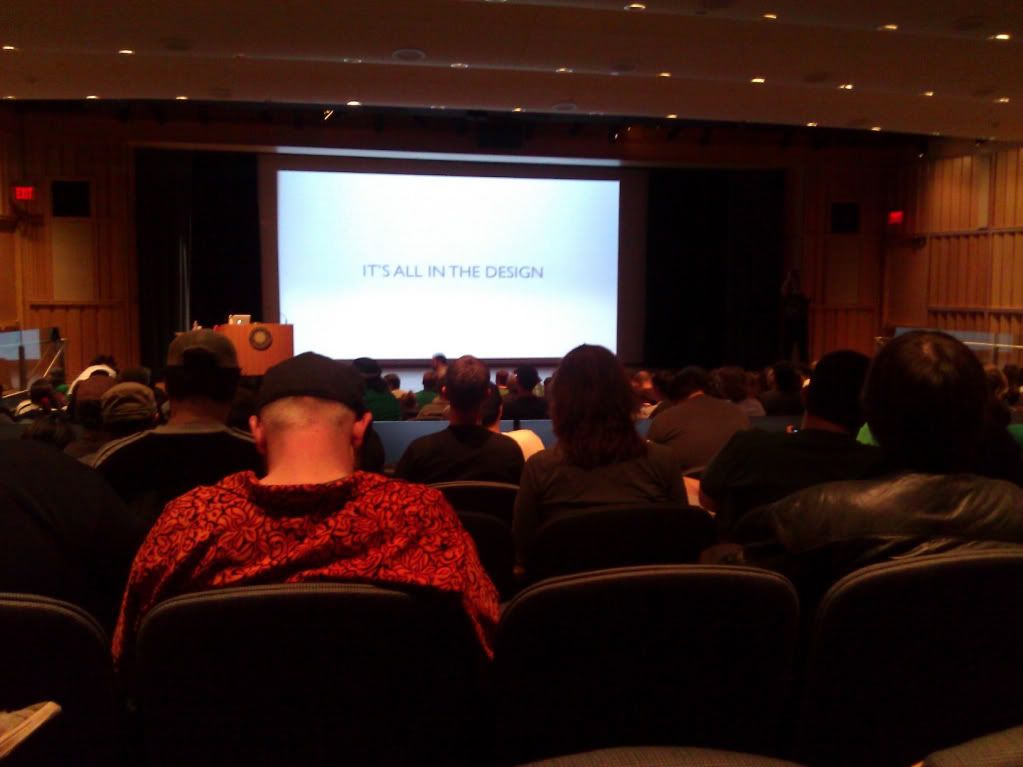Fear and Loathing in the DC Smithsonian
|
“What is this generation’s Pac-Man?” It’s a question posed to my associate and I during a late night smoking cigarettes outside of the Washington Hilton, asked by a short, sunglasses-clad African-American in his late twenties. I previously told him I was a game journalist here to cover GameFest, to which he asked what games I review. “I don’t really review games,” I responded. “I’m more of a critic of the culture as a whole. In fact, I don’t even have much time to play that many games anymore.” He seemed somewhat mystified, wondering what a game journalist who doesn’t review or play games was doing masquerading as one. But then again, we were in a city filled with phonies and liars – sometimes it’s good to blend in. But his bewilderment was satisfied when he asked that significant question – the question that made my job title and reason in DC that much more apparent. One of us answered Grand Theft Auto, the other Angry Birds – two very different answers with very different reasoning. This led to a discussion of whether Pac-Man meant “icon” or mass appeal. In the 80s, anyone strolling through the mall or a pizza shop could slip a few quarters in the machine and play Pac-Man for as little or long as they liked. Today, our smartphones are our malls – we browse, try and purchase apps that augment our lives. Angry Birds matches Pac-Man in this sense, and in the sense of an overtly popular product enjoyed across the gamut from young to old. As an icon, however, Angry Birds doesn’t resonate so much as Pac-Man did, and still continues to do. The answer wound down to Mario, Sonic and other iconic game characters, but that begged another question: what was meant by “this generation?” If it were the social generation, then Angry Birds definitely seems the apt comparison. But if it were the generation that the three of us grew up in, then what the hell was our Pac-Man? Did it even matter? Or were we all too drunk by this point to even know what we were talking about? And for that matter, who was this strange guy? This guy who couldn’t even remember the title or main character of Metal Gear Solid: how could he pose such a sapient question? I looked forward to GameFest and the Smithsonian’s Art of Video Games even more now, if for nothing other than enlightenment. Our paranoia set in further as we stumbled through the hotel to breakfast. Unsure of our status as complimentary guests, we tried our key in the elevator to access the 10th floor breakfast level to no avail. After a few tries we were on our way, but only because another Hiltonite had called the elevator. We were in, but now came the hard part – trying to keep it together long enough to blend in with this elitist crowd. I managed well enough, but my friend had no such luck. The croissant he picked up with the tongs fell off his palm-sized plate and bounced, circling toward the middle of the floor. The pack stared violently at my associate, then to the croissant and back again to him, as if to say “what are you going to do now?” It was a test to see if he were one of them. Perhaps he should’ve picked up the croissant, excused himself, and disposed of it. Perhaps he should’ve pretended he didn’t notice at all. But he turned to meet the pack’s judging stares, spun back around, set the tongs down on the table, grabbed a new croissant with his bare hands and walked away. They were on to us — we didn’t belong here with these privileged breakfast folk who were most likely among the highest ranks in their respective professions. We may have passed their test had we been legitimate artsy people, but we were videogame people, and contrary to the Smithsonian’s belief, videogames were not a welcome part of the elitist community. We were “new money,” so to speak; here because of novelty and curiosity and nothing more. The only thing to do now was to embrace our conduct, eat quickly and leave.
The Smithsonian was brimming with activity – the rigid, stuffy atmosphere of the traditional art world had been replaced, if only temporary, to take on a more commercial front. There was no sense of direction, of coherence, upon entering. Wide-eyed attendees trudged aimlessly, just trying to make sense of it all. My associate and I navigated through the crowd to the center, where a portly young man was standing with two books titled The Art of Video Games: From Pac-Man to Mass Effect. “Are these for sale?” I asked. He nodded and pointed to the museum shop, which had blended in with the traffic of the crowd. We casually entered the shop which was pouring outside the door with consumers purchasing swag to commemorate the acceptance of video games into the art community. We glanced around and exited. This felt less like an art showing and more like a commercial entertainment event. It was jarring that just down the halls protruding from this central hub were collections of impressionists, realists and abstract paintings of the 19th and 20th centuries. These halls were all but empty, and those that were there were probably searching for the Art of Video Games exhibit. This was very much our day. Out in the courtyard the GameFest crowd was less concentrated, but the focus was meandering – there were open play activities, tables for pixel art, photo booths and tables to sit and contemplate your museum purchases. A familiar song began blaring over the scattered crowd – the Zelda theme, played by The Triforce Quartet. Right in front of the stage area was the Genesis Sonic the Hedgehog and all around were displays playing retro and modern games like Top Gun and Space Channel 5.
“This is nothing,” said an elderly lady who worked at the museum. “The line for the exhibit was out the front door earlier.” Now it was just echoing down the intimidating halls of the third floor, but with easily two to three hundred people still waiting in line to glimpse the art of video games. The crowd was mixed – from the very young to twenty-something’s to the middle-aged – there either deliberately or out of curiosity. Many who grew up in the game culture were hoping for a more artistic view of video games and were somewhat put off by the commercial atmosphere and obvious exhibition choices. Those who were curious outsiders, and mostly over forty, were awed: “It was absolutely amazing,” said the same museum worker outside on the steps of the Smithsonian. An elderly (and quite possibly homeless) man next to her agreed. “Amazing,” he repeated, before regaling us with stories of the injustices done to him by the DC police.
At a quarter to five, we excused ourselves from the old man’s tales and made our way down the steps and into the auditorium for Robin Hunicke’s “It’s All in the Design” lecture. The auditorium filled quickly, this time with concentrations of core gaming enthusiasts. After a brief introduction by Chris Melissinos, curator of the exhibit, Robin Hunicke took to the stage. She eased into her presentation and reassured the aspiring designers in the audience by mentioning she was brought on as a Sims 2 designer when she “was 32 years old and had never worked on a commercial game.” She spoke, at first, in a rehearsed manner, gesturing expressively with her hands. Her lecture touched on communication breakdowns and successful collaboration methods before getting into the real art behind game design, which turned out to be more psychology than art. “You can develop an ability to truly see through someone’s eyes to see both sides of a design – to see both sides of a problem,” said Robin. She explained the challenge of creating something compelling to players of all ages – quite the opposite of the traditional artist who discovers freedom through not acknowledging the impression he is going to make – the videogame artist is much more deliberate. This was the case with Robin’s design methodology, at least until she moved to LA to work on a new game. “The core principle of this game design was experimentation,” said Robin. “It was that people should feel comfortable playing to fail.” Her presentation moved toward more appropriate art territory rather than the art-sucker of appealing to everyone. She was learning to design to evoke a specific reaction from the player. “Not only do you need to focus on the exact right point in the design and really nail that one problem, you need to do it with the help of everyone at your disposal,” continued Robin, who concluded her lecture by discussing Journey. She put it out there that, in designing Journey, it was her “hope that players who meet each other online could experience a genuine human connection with each other.” Through years of game design trial and error, successes and failures, Robin Hunicke had finally tapped into the true art of games – one that explores the state of humanity and the nature of existence. “In much the same way as when you’re hiking in the wilderness, you might stop to take in the view or introduce yourself, or just even smile, at a passing stranger; whereas if you saw them on a crowded train you would just look right through them.” A simple elimination of player tags helped foster this goal organically rather than pushing it on the player.
As we boarded the metro back to Vienna, I remembered the Pac-Man question. The exhibit failed to give me a concrete answer, but I did leave the event enlightened. Just then, a girl wedged through the closing doors of the train, despite the warnings of her friends. One of her friends made it through but the last one got left behind. I thought about Robin’s train analogy, and of interaction, of connection. I would have to put myself out there to evoke a reaction that would create a connection in the real world. It’s a deliberate choice, and a choice that true art evokes from its audience. If you simply read a story and don’t think about it, it’s nothing more than printed words on a page. If you stare at a painting and don’t contemplate it, it’s just a collision of color. If you play a videogame, and by the end of it you haven’t taken anything with you but a high score, then maybe it’s not art. Videogames are a business with artistic sensibilities, and it shows in the Smithsonian’s exhibition. While the Smithsonian playing host to a videogames event was tremendous in that fact alone, the festivities and exhibition failed to explore the territory game journalism has been fearlessly covering for years now. It was clear that we were still not quite there as an art form, as only certain games have broken through that barrier, but we had broken through. The breakfast incident, however, made us acutely aware that we were in DC’s Smithsonian as novelty only: not fully accepted, still wet behind the ears. But I say to those elitist Hiltonites that we are going to sit among you anyway, drop our croissants and not give a damn what you think of us at all.
|

